Search
- Page Path
-
- HOME
- Search
- Original Article
- Neonatology (Perinatology)
- Neonatal sepsis-causing bacterial pathogens and outcome of trends of their antimicrobial susceptibility a 20-year period at a neonatal intensive care unit
- Woo Sun Song, Hye Won Park, Moon Youn Oh, Jae Young Jo, Chae Young Kim, Jung Ju Lee, Euiseok Jung, Byong Sop Lee, Ki-Soo Kim, Ellen Ai-Rhan Kim
- Clin Exp Pediatr. 2022;65(7):350-357. Published online December 9, 2021
-
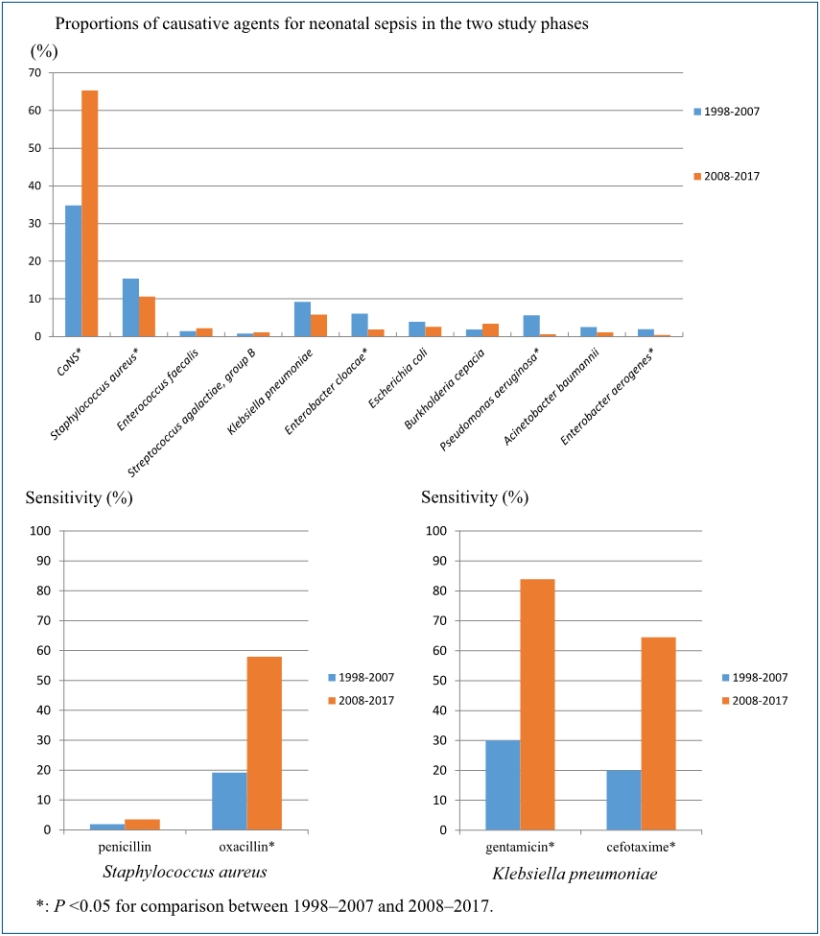
Question: What is prevalence of bacterial pathogens causing sepsis and their antimicrobial susceptibility over 20 years?
Finding: Coagulase-negative remains most common causative organism. The most common gram-negative organism was Klebsiella pneumonia. The susceptibility of staphylococcus aureus and K. pneumonia showed increased susceptability to oxacillin, cefotaxime and amikacin, gentamicin, respectively.
Meaning: Answers to the question asked is important in choosing antimicrobials and to monitor emergence of multidrug-resistant organisms.
- Risk-based maternal group B Streptococcus screening strategy is compatible with the implementation of neonatal early-onset sepsis calculator
- Niek B. Achten, J. Wendelien Dorigo-Zetsma, Annemarie M.C. van Rossum, Rianne Oostenbrink, Frans B. Plötz
- Clin Exp Pediatr. 2020;63(10):406-410. Published online April 16, 2020
-
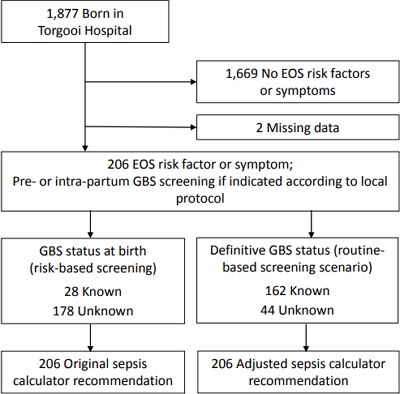
Question: To what extent does risk-based Group B Streptococcus (GBS) screening influence management recommendations by the early-onset sepsis (EOS) calculator?
Finding: In 97% of the newborn infants, the EOS calculator recommendation remained unchanged after the GBS status at birth was updated to the definitive GBS status.
Meaning: Risk-based GBS screening results are compatible with EOS calculator recommendations.
- Synbiotics use for preventing sepsis and necrotizing enterocolitis in very low birth weight neonates: a randomized controlled trial
- Ozge Serce Pehlevan, Derya Benzer, Tugba Gursoy, Guner Karatekin, Fahri Ovali
- Clin Exp Pediatr. 2020;63(6):226-231. Published online February 5, 2020
-
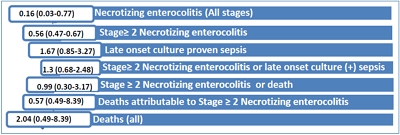
Background: Probiotics and prebiotics have strain-specific effects on the host. Synbiotics, a mixture of probiotics and prebiotics, are proposed to have more beneficial effects on the host than either agent has alone.
Purpose: We performed a randomized controlled trial to investigate the effect of Lactobacillus and Bifidobacterium together with oligosaccharides and lactoferrin on the development of necrotizing enterocolitis (NEC) or sepsis...
- Diagnostic value of eosinopenia and neutrophil to lymphocyte ratio on early onset neonatal sepsis
- Rocky Wilar
- Clin Exp Pediatr. 2019;62(6):217-223. Published online October 8, 2018
-
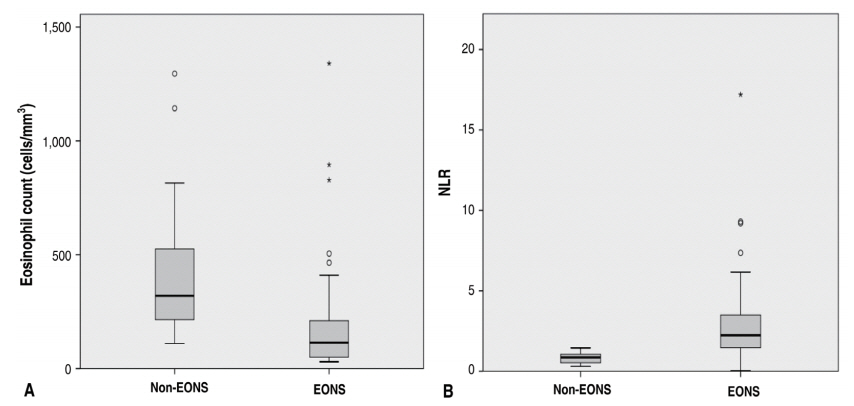
Purpose: To determine the diagnostic value of eosinopenia and the neutrophil-to-lymphocyte ratio (NLR) in the diagnosis of early onset neonatal sepsis (EONS). Methods: This cross-sectional study was conducted in the Neonatology Ward of R.D. Kandou General Hospital Manado between July and October 2017. Samples were obtained from all neonates meeting the inclusion criteria for EONS. Data were encoded using logistic regression...
- Clinical features and prognostic factors of early-onset sepsis: a 7.5-year experience in one neonatal intensive care unit
- Se Jin Kim, Ga Eun Kim, Jae Hyun Park, Sang Lak Lee, Chun Soo Kim
- Clin Exp Pediatr. 2019;62(1):36-41. Published online September 27, 2018
-
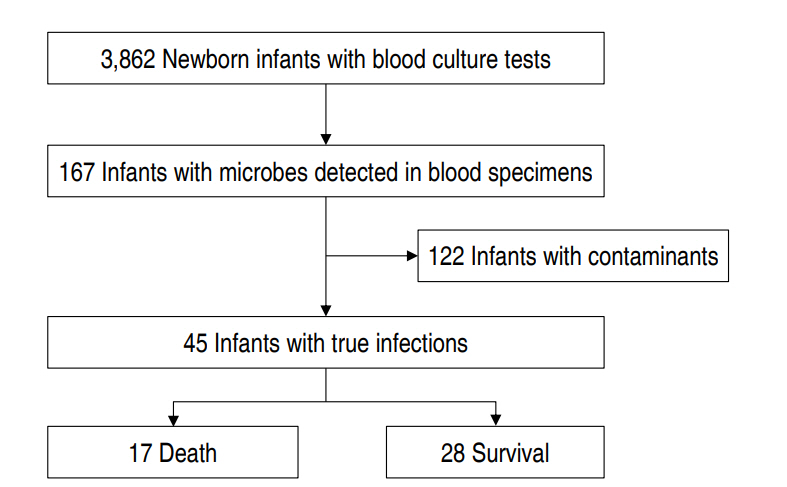
Purpose: In this study, we investigated the clinical features and prognostic factors of early-onset sepsis (EOS) in neonatal intensive care unit (NICU) patients. Methods: A retrospective analysis was conducted on medical records from January 2010 to June 2017 (7.5 years) of a university hospital NICU. Results: There were 45 cases of EOS (1.2%) in 3,862 infants. The most common pathogen responsible for...
- Diagnostic and prognostic value of proadrenomedullin in neonatal sepsis
- Sameh Samir Fahmey, Heba Mostafa, Noha Abd Elhafeez, Heba Hussain
- Clin Exp Pediatr. 2018;61(5):156-159. Published online May 28, 2018
-

Purpose Sepsis is a major cause of neonatal morbidity and mortality. Early diagnosis is a major problem because of the lack of specific clinical signs. Therefore, a reliable diagnostic marker is needed to guide the use of antimicrobial agents. The objective of our study was to assess the value of proadrenomedullin (pro-ADM) in establishing the diagnosis and evaluating the prognosis of...
- Effects of cord blood vitamin D levels on the risk of neonatal sepsis in premature infants
- Birgul Say, Nurdan Uras, Suzan Sahin, Halil Degirmencioglu, Serife Suna Oguz, Fuat Emre Canpolat
- Clin Exp Pediatr. 2017;60(8):248-253. Published online August 14, 2017
-
Purpose Vitamin D plays a key role in immune function. Vitamin D deficiency may play a role in the pathogenesis of infections, and low levels of circulating vitamin D are strongly associated with infectious diseases. In this study, we aimed to evaluate the effects of low vitamin D levels in cord blood on neonatal sepsis in preterm infants.
Methods One hundred seventeen premature...
- Case Report
- Urosepsis and postrenal acute renal failure in a neonate following circumcision with Plastibell device
- Meena Kalyanaraman, Derrick McQueen, Joseph Sykes, Tej Phatak, Farhaan Malik, Preethi S. Raghava
- Clin Exp Pediatr. 2015;58(4):154-157. Published online April 22, 2015
-
Plastibell is one of the three most common devices used for neonatal circumcision in the United States, with a complication rate as low as 1.8%. The Plastibell circumcision device is commonly used under local anesthesia for religious circumcision in male neonates, because of cosmetic reasons and ease of use. Occasionally, instead of falling off, the device may get buried under...
- Neonatal invasive
Streptococcus gallolyticus subsp.pasteurianus infection with delayed central nervous system complications - Jung-Weon Park, So-Hee Eun, Eui-Chong Kim, Moon-Woo Seong, Yun-Kyung Kim
- Clin Exp Pediatr. 2015;58(1):33-36. Published online January 31, 2015
-
Group D streptococci are known to cause newborn septicemia and meningitis, but the
Streptococcus bovis group strains rarely cause serious neonatal infections in Korea. Central nervous system (CNS) complications of neonatalS. bovis group infection have rarely been reported. In adults,S. bovis group strains cause bacteremia and endocarditis, and are associated with gastrointestinal malignancy. However, only a few studies...
- Original Article
- Serum procalcitonin as a diagnostic marker of neonatal sepsis
- In Ho Park, Seung Hyun Lee, Seung Taek Yu, Yeon Kyun Oh
- Clin Exp Pediatr. 2014;57(10):451-456. Published online October 31, 2014
-
Purpose We evaluated serum procalcitonin (PCT) as a diagnostic marker of neonatal sepsis, and compared PCT levels with C-reactive protein (CRP) levels.
Methods We retrospectively reviewed the medical records of 269 neonates with a suspected infection, admitted to Wonkwang University School of Medicine & Hospital between January 2011 and December 2012, for whom PCT and CRP values had been obtained. Neonates were categorized...
- Early-onset sepsis in a neonatal intensive care unit in Beni Suef, Egypt: bacterial isolates and antibiotic resistance pattern
- Sameh Samir Fahmey
- Clin Exp Pediatr. 2013;56(8):332-337. Published online August 27, 2013
-
Purpose To identify the frequency of bacterial isolates in early-onset neonatal sepsis (EONS) and their antimicrobial resistance pattern.
Methods A retrospective study of EONS was conducted at the Beni Suef University Hospital from September 2008 to September 2012. A case of EONS was defined as an infant who had clinical signs of infection or who was born to a mother with risk factors...
- The control of invasive
Candida infection in very low birth weight infants by reduction in the use of 3rd generation cephalosporin - Yu Jin Chang, Il Rak Choi, Won Sub Shin, Jang Hoon Lee, Yun Kyung Kim, Moon Sung Park
- Clin Exp Pediatr. 2013;56(2):68-74. Published online February 25, 2013
-
Purpose To evaluate the effectiveness of new management policies on the incidence of invasive Candida infections
Methods This observational study involved a retrospective analysis of the patients' medical records. In total, 99 very low birth weight infants, who were admitted to the neonatal intensive care unit at Ajou University Hospital from January 2010 to December 2011, were enrolled for the study. Period I,...
- Comparison of the accuracy of neutrophil CD64 and C-reactive protein as a single test for the early detection of neonatal sepsis
- Young Kwang Choo, Hyun-Seok Cho, In Bum Seo, Hyeon-Soo Lee
- Clin Exp Pediatr. 2012;55(1):11-17. Published online January 31, 2012
-
Purpose Early identification of neonatal sepsis is a global issue because of limitations in diagnostic procedures. The objective of this study was to compare the diagnostic accuracy of neutrophil CD64 and C-reactive protein (CRP) as a single test for the early detection of neonatal sepsis.
Methods A prospective study enrolled newborns with documented sepsis (n=11), clinical sepsis (n=12) and control newborns (n=14). CRP,...
- Analysis of neonatal sepsis in one neonatal intensive care unit for 6 years
- Peter Chun, Seom Gim Kong, Shin Yun Byun, Su Eun Park, Hyung Du Lee
- Clin Exp Pediatr. 2010;53(4):495-502. Published online April 15, 2010
-
Purpose : Sepsis is a significant cause of morbidity and mortality in the newborn, particularly in preterm. The objective of this study was to analyze the incidence rate, causative pathogens and clinical features of neonatal sepsis in one neonatal intensive care unit (NICU) for 6 years. Methods : This study was retrospectively performed to review the clinical and laboratory characteristics including sex, gestational age,... -
- Review Article
- Systemic lupus erythematosus
- Kwang-Nam Kim
- Clin Exp Pediatr. 2007;50(12):1180-1187. Published online December 15, 2007
-
Systemic lupus erythematosus (SLE) is an episodic, multi-system, autoimmune disease characterized by widespread inflammation of blood vessels and connective tissues and by the presence of antinuclear antibodies (ANAs), especially antibodies to native (double-stranded) DNA (dsDNA). Its clinical manifestations are extremely variable, and its natural history is unpredictable. Untreated, SLE is often progressive and has a significant fatality rate. The most... -
- Original Article
- Platelet count and mean platelet volume in low birth weight infants (≤2,000 g) with sepsis
- Wan-soo Lee, Jin-young Cho, Seung-taek Yoo, Chang-woo Lee, Doo-young Choi, Jong-duck Kim, Yeon-kyun Oh
- Clin Exp Pediatr. 2007;50(7):643-648. Published online July 15, 2007
-
Purpose : Sepsis is a common complication in Neonatal Intensive Care Units (NICU), seen especially in low birth weight (LBW) infants. A recent study showed that fungal or gram-negative sepsis is associated with a greater degree of thrombocytopenia than is seen with gram-positive sepsis. So, this study was undertaken to examine the platelet counts and platelet indices in LBW infants... -
- Diagnostic value of various screening tests in neonatal sepsis
- Hyun Gon Je, Young Mi Jeoung, Soo Jin Jeong
- Clin Exp Pediatr. 2006;49(11):1167-1173. Published online November 15, 2006
-
Purpose : To evaluate various sepsis screening tests, individually and in combination, to formulate a guideline for the diagnosis of neonatal sepsis. Methods : The study was a retrospective cohort study. It took place at the neonatal intensive care unit of the Paediatric Department, Il Sin Christian Hospital, Busan, Korea, over a period of 68 months from 1st, April, 2001 to... -
- Analysis of causative microorganisms and choice of antibiotics according to the onset of neonatal sepsis
- June Seung Sung, Dong Yeon Kim, Sun Hee Kim, Hyung Suk Byun, Tai Ju Hwang, Young Youn Choi
- Clin Exp Pediatr. 2006;49(6):623-629. Published online June 15, 2006
-
Purpose : The mortality rate of neonatal sepsis has been decreased, however, the incidence has not significantly decreased because of increased invasive procedures. This study was designed to make guidelines for choosing antibiotics by analyzing the causative microorganisms and their antibiotics sensitivity test according to the onset of neonatal sepsis. Methods : One hundred seven cases of culture proven sepsis... -
- The Effectiveness of Intravenous Immunoglobulin for Clinically Suspected Neonatal Sepsis
- Hyun Jung Na, Ji Young Kim, Gyeong Hoon Lee, Jun Hwa Lee, Eun Jin Choi, Jin Kyung Kim, Hai Lee Chung, Woo Taek Kim
- Clin Exp Pediatr. 2005;48(11):1187-1192. Published online November 15, 2005
-
Purpose : The purpose of this study is to determine the effectiveness of intravenous immunoglobuin (IVIG) administration in fullterm neonates having clinically suspected neonatal sepsis. Methods : Forty full-term neonates admitted to the neonatal intensive care unit with clinically suspected neonatal sepsis, who had at least two positive diagnostic criteria were enrolled. Twenty neonates were enrolled into the IVIG arm and... -
- Clinical Use and Complications of Percutaneous Central Venous Catheterization in Very Low Birth Weight Infants
- Hyang Kim, Sun Hui Kim, Hyung Suck Byun, Young Youn Choi
- Clin Exp Pediatr. 2005;48(9):953-959. Published online September 15, 2005
-
Purpose : The administration of total parenteral nutrition(TPN) has become a standard procedure in the management of nutritionally deprived and critically low birth weight neonates. Sepsis remains the most frequent serious complication during TPN, resulting in increased morbidity, mortality and health care costs. This study was performed to evaluate the clinical efficacy and complications of percutaneous central venous catheterization(PCVC) in... -
- A Clinical Study of Sepsis with Thrombocytopenia in Premature Infants
- Jae Hoon Sim, So Ick Jang, Yun Jung Sim, Do Jun Cho, Dug Ha Kim, Ki Sik Min, Ki Yang Yoo
- Clin Exp Pediatr. 2004;47(10):1058-1064. Published online October 15, 2004
-
Purpose : This study was performed to characterize sepsis with thrombocytopenia in premature infants to determine if thrombocytopenia is a prognostic factor in sepsis in premature infants. Methods : We retrospectively analyzed the medical records of sepsis in premature infants admitted to the neonatal intensive care unit(N=41) at the Hallym University Sacred Heart Hospital from January 1999 to December 2002. The... -
- Cytokines in Neonatal Sepsis
- Hye Jin Park, So Yeon Kim, Jun Hwa Lee, Eun Jin Choi, Jin Kyung Kim, Sang Gyung Kim, Hai Lee Chung, Woo Taek Kim
- Clin Exp Pediatr. 2004;47(5):515-520. Published online May 15, 2004
-
Purpose : Maternal premature rupture of membrane(PROM) over 24 hours is a risk factor in neonatal sepsis and a main cause of administration to neonatal intensive care unit. Levels of proinflammatory cytokines were studied to diagnose and treat early in newborn infants with sepsis and with a history of maternal PROM. Methods : Interleukin-1β(IL-1β), Interleukin-6(IL-6), Interleukin-8(IL-8), and tumor necrosis factor-α(TNF-α) were... -
- Clinical Findings of Sepsis-Associated Cholestasis in the Neonates
- Soo Jung Yoon, Chun Soo Kim, Sang Lak Lee
- Clin Exp Pediatr. 2004;47(4):380-385. Published online April 15, 2004
-
Purpose : Bacterial endotoxins or inflammatory cytokines are known to be important causes of cholestasis in patients with systemic infections such as sepsis. This study was undertaken to investigate the clinical features of cholestasis in newborn infants with sepsis. Methods : This study included 17 neonates with cholestasis diagnosed at the time of septicemia who had no previous history of cholestasis.... -
- Prevalence and Risk Factors of Candida Sepsis in Neonatal Intensive Care Unit
- Ic Sun Choi, Suk Hwan Lim, Chang Yee Cho, Young Youn Choi, Tai Ju Hwang
- Clin Exp Pediatr. 2002;45(7):836-846. Published online July 15, 2002
-
Purpose : With the development of neonatal intensive care and the increased use of systemic antibiotics, candida sepsis has become one of the most important causes of neonatal morbidity and mortality. The purpose of this study was to investigate the prevalence rate and its associated risk factors. Methods : We retrospectively reviewed medical records of 28 cases with candida sepsis who... -
- Therapeutic Effect of Different Doses of Recombinant Human Granulocyte Colony-Stimulating Factor(rhG-CSF) on Neonatal Sepsis Complicated by Neutropenia
- Moon Young Choi, Yeon Sook Jung, Dong Woo Son, Hyo Seop Ahn
- Clin Exp Pediatr. 2002;45(4):439-448. Published online April 15, 2002
-
Purpose : The aim of this study is to determine and compare the effects of adjunctive therapy with different doses of recombinant human granulocyte-colony stimulating factor(rhG-CSF) on reversing sepsis-associated neonatal neutropenia, and their survival rate in a group I/II-type trial. Methods : RhG-CSF was injected subcutaneously to 10 septic-neutropenic neonates with doses of 10 μg/kg from Oct. 1995 to Sep. 1996,... -
- The Change of White Blood Cell Count Following Transfusion in Preterm Neonates
- Soo Young Yoon, Gum Joo Lee, Gui Young Jung
- Clin Exp Pediatr. 2002;45(3):325-330. Published online March 15, 2002
-
Purpose : We intended to find out how the red cell transfusion would change the white cell count in preterm neonates under treatment in the intensive care unit. We also speculated whether the magnitude of such a change could indicate a potential neonatal infection. Methods : Total white blood cell count, total neutrophil count, and band count were compared and analyzed... -
- A Nationwide Survey on the Causative Organisms of Neonatal Sepsis in Korea
- Kyung Ah Kim, Son Moon Shin, Jung Hwan Choi
- Clin Exp Pediatr. 2002;45(1):55-63. Published online January 15, 2002
-
Purpose : A nationwide survey was conducted to investigate the most common causative organisms in neonatal sepsis in Korea. Methods : By reviewing medical records of newborn infants who were confirmed as neonatal sepsis by isolating organisms from blood culture during a one year study period from January to December in 1997, data for causative organisms, risk factors, accompanying focal infections and combinations of antibiotics... -
- Effect of Parenteral Nutrition Guideline Changes on Neonatal Sepsis in Premature Infants
- Chang-Ryul Kim, Jae-Won Oh, Myung-Kul Yum, Soo-Jee Moon
- Clin Exp Pediatr. 2001;44(6):620-626. Published online June 15, 2001
-
Purpose : We hypothesized that decreased parenteral nutrition would lower the incidence of neonatal sepsis in premature infants. Methods : The study involves 223 premature infants who were admitted to the neonatal intensive care unit of Hanyang University Kuri Hospital from July 1995 to January 1999. Infants were divided into two groups based on different parenteral nutrition guidelines : Old... -
- Effect of Granulocyte-macrophage Colony-stimulating Factor in Neonatal Infection
- Il-Young Jo, Sang-Hyun Byun
- Clin Exp Pediatr. 2000;43(12):1552-1557. Published online December 15, 2000
-
Purpose : Neutrophils are central to the defences against bacterial infection, and in neonates the number of neutrophils are decreased due to inhibited production and phagocytic function. This induces high mortality rates in infants suffering from neonatal sepsis. Exogenous GM-CSF can increase the number of neutrophils and improve the phagocytic function. To establish the most cost effective dose of exogenous... -
- Risk Factors for Neonatal Sepsis in Premature Infants Admitted to Neonatal Intensive Care Unit
- Chang-Ryul Kim, Jae-Won Oh, Myung-Kul Yum, Soo-Jee Moon
- Clin Exp Pediatr. 2000;43(9):1174-1179. Published online September 15, 2000
-
Purpose : The purpose of this study is to find out the risk factors of sepsis except the prematurity itself. Methods : Seventy-seven premature infants less than 37 weeks of gestation, who were admitted to the neonatal intensive care unit of Hanyang University Kuri Hospital between July 1995 and December 1996, were enrolled in this study. All 77 premature infants, 14... -
-

-
-

-

-
Impact Factor4.2
-
6.52022CiteScore92nd percentilePowered by







